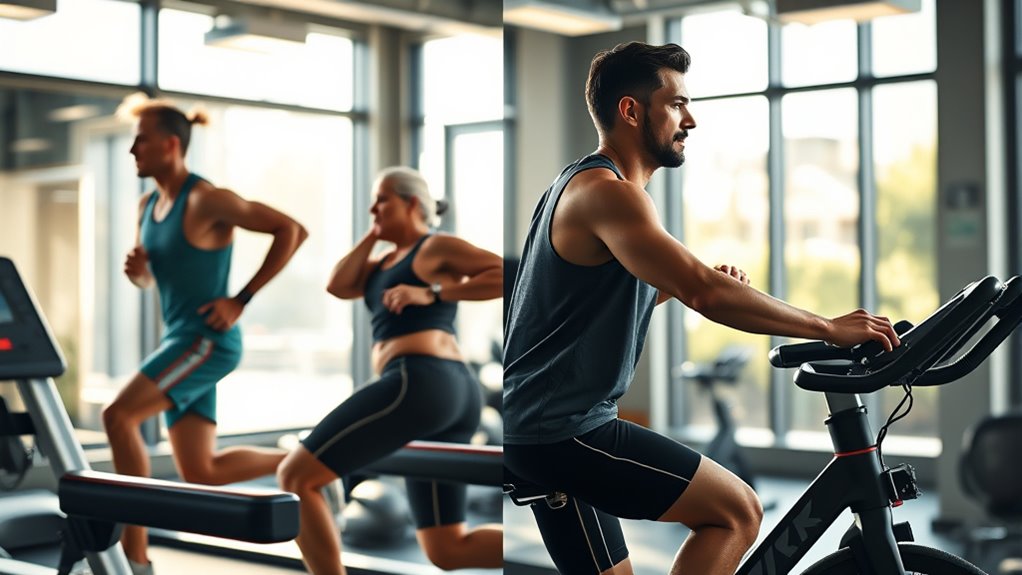Cardio training methods like HIIT and steady state offer different benefits to match your goals. HIIT involves quick bursts of intense effort followed by rest, burning calories fast and boosting cardiovascular capacity efficiently. Steady state requires maintaining a moderate pace for longer periods, building endurance and stamina over time. Whether you want quick fat loss or longer-lasting endurance, choosing the right approach can maximize your results. Keep exploring to discover which method suits your needs best.
Key Takeaways
- HIIT involves short, intense effort bursts with recovery periods, boosting calorie burn and cardiovascular capacity efficiently in 20-30 minutes.
- Steady state cardio maintains a consistent moderate effort (50-70% HR) for extended periods, enhancing endurance and fat burning gradually.
- HIIT activates anaerobic energy systems, engaging rapid muscle fibers, while steady state relies on aerobic pathways for sustained oxygen use.
- HIIT is ideal for quick fat loss and time-efficient workouts; steady state supports long-term endurance and joint health.
- Choosing between methods depends on personal goals, schedule, fitness level, and preference, ensuring safe and effective training.
Understanding High-Intensity Interval Training (HIIT)

Have you ever wondered how to maximize your workout in less time? That’s where high-intensity interval training (HIIT) shines. By alternating between short bursts of intense effort and recovery periods, you boost your aerobic capacity efficiently. Interval training pushes your body to work harder, helping you burn more calories in less time. It also enhances cardiovascular health and builds endurance faster than steady-state cardio. You don’t need hours to see results; just a few focused sessions weekly can make a big difference. With HIIT, you challenge your body, improve your fitness level, and save time. It’s perfect if you’re looking for a powerful, time-efficient way to elevate your cardio routine and achieve your health goals quicker.
Exploring Steady State Cardio

While high-intensity workouts have gained popularity, steady state cardio remains a fundamental training method. During this type of workout, you maintain a consistent pace that keeps your heart rate in the moderate zone, typically around 50-70% of your maximum. This approach emphasizes sustained effort, allowing your cardiovascular system to adapt gradually. Steady state cardio offers a valuable way to boost endurance without the fatigue associated with intense intervals. It also encourages workout variety, preventing boredom and reducing injury risk by avoiding constant high-impact movements. By staying in your target heart rate zones for an extended period, you develop a solid aerobic base, improve fat burning, and build stamina, making it an essential component of a well-rounded fitness routine. Relationships – Personality Test
Key Differences Between HIIT and Steady State

You’ll notice that HIIT involves short bursts of high intensity with brief rest periods, unlike steady state cardio, which maintains a consistent, moderate effort over time. These differences affect how your body taps into energy systems and recovers afterward. Understanding these key distinctions helps you choose the right method for your fitness goals. Additionally, portable power stations can provide reliable energy for outdoor workouts or training sessions, supporting your fitness routine anywhere.
Intensity and Duration
Understanding the differences in intensity and duration is essential when comparing HIIT and steady-state cardio. With HIIT, you push your heart rate to near maximum during short bursts, typically lasting 20 to 40 seconds. The workout duration is shorter overall, often around 20 to 30 minutes, but involves intense effort. In contrast, steady-state cardio keeps your heart rate elevated at a moderate level for a longer period, usually 45 minutes to an hour, with consistent effort throughout. This sustained activity results in a longer workout duration, focusing on endurance. Additionally, the refresh rates of the exercises influence how your body responds, with HIIT demanding rapid recovery and steady-state promoting sustained energy expenditure. By adjusting the intensity and duration, you tailor your cardio sessions to meet specific fitness goals, whether improving aerobic capacity or maximizing calorie burn in a shorter time.
Energy System Engagement
Have you ever wondered how different cardio methods activate your body’s energy systems? With HIIT, you recruit more muscle fibers quickly, relying heavily on anaerobic energy pathways for short bursts of intense effort. This accelerates muscle recruitment and pushes your body to utilize stored glycogen and phosphocreatine, minimizing oxygen utilization. In contrast, steady state cardio engages your aerobic system more consistently, emphasizing oxygen utilization to sustain longer durations. You activate fewer muscle fibers at a time but keep your body oxygen-rich, promoting fat burning and endurance. The key difference lies in how your energy systems respond: HIIT maximizes anaerobic energy with rapid muscle recruitment, while steady state emphasizes aerobic pathways, optimizing oxygen use over extended periods. Understanding this helps tailor your training to specific fitness goals. Additionally, incorporating muscle fiber recruitment strategies can further enhance your training efficiency.
Recovery and Rest
After pushing your body through intense efforts in HIIT, recovery becomes a vital part of your training process. Proper rest strategies help facilitate muscle recovery, preventing injury and overtraining. With HIIT, you need longer recovery periods between sessions to allow your muscles to repair and reduce fatigue. Active recovery, like light stretching or walking, can promote blood flow and speed up muscle recovery. In contrast, steady state cardio typically involves less intense effort, meaning shorter or less structured rest periods. Regardless of the method, listening to your body is key. Incorporate adequate rest days and prioritize sleep to optimize recovery, ensuring you’re ready for your next session. Proper recovery not only enhances performance but also minimizes the risk of burnout.
Benefits of Incorporating HIIT Into Your Routine

Ever wondered how you can maximize your workout time and see results faster? Incorporating HIIT into your routine offers several benefits. First, it boosts your cardio variety, preventing boredom and plateaus. Second, HIIT helps you burn more calories in less time by alternating intense effort with recovery periods. Third, it improves your workout pace, making you more efficient during sessions. Fourth, this method increases your metabolic rate post-exercise, leading to continued calorie burn afterward. By mixing up your cardio, you challenge different muscle groups and energy systems, resulting in better overall fitness. Plus, HIIT’s flexibility allows you to tailor sessions to fit your schedule, making it easier to stay consistent and motivated. Incorporating techniques like glycolic acid in skincare routines can enhance skin health and recovery, supporting your active lifestyle. Overall, adding HIIT keeps your routine dynamic and effective.
Advantages of Steady State Cardio for Endurance

Steady state cardio is an effective way to build and enhance your endurance over time. It helps you improve your muscle endurance by maintaining a consistent effort, allowing your muscles to adapt and become more resilient. This method also boosts your aerobic capacity, enabling your body to efficiently use oxygen during prolonged activity. As you sustain steady activity, your heart and lungs become more efficient at delivering oxygen to your muscles, increasing overall stamina. Unlike intense, short bursts, steady state cardio promotes long-term gains in endurance without excessive fatigue. This makes it ideal for those looking to improve sustained performance, whether for running, cycling, or other endurance sports. Over time, these adaptations help you perform longer and recover faster during your workouts. Incorporating consistent effort into your routine is key to maximizing these benefits and achieving lasting improvements.
Suitable Fitness Goals for Each Method

Choosing the right cardio training method depends on your specific fitness goals. If you’re aiming for muscle growth, steady state cardio can help build endurance without stressing your joints, making it a safer choice. For improving joint health, steady state workouts are gentle and reduce injury risk. Conversely, if your goal is fat loss or boosting cardiovascular capacity quickly, HIIT is more effective with its intense bursts. Consider these goals:
Choose steady state for endurance and joint health; opt for HIIT to burn fat and boost cardio capacity efficiently.
- Muscle Growth – Opt for steady state cardio to avoid overtaxing muscles and joints.
- Joint Health – Choose low-impact, steady state activities like walking or swimming.
- Fat Loss – Use HIIT for efficient calorie burn in less time.
- Cardiovascular Endurance – Both methods work, but steady state enhances sustained stamina.
Match your method to your goals for ideal results.
Time Commitment and Intensity Levels

The time you dedicate to cardio training and the intensity at which you perform it particularly impact your fitness results. If you’re short on time, high-intensity interval training (HIIT) allows you to maximize effort in less time, often with just 20-30 minutes using minimal exercise equipment or outdoors. Steady-state cardio, on the other hand, requires longer sessions at a moderate pace, whether on a treadmill, bike, or during outdoor activities like running or cycling. Your chosen intensity level influences calorie burn and endurance development. Higher intensities challenge your cardiovascular system more quickly, but they also demand more recovery. Balancing time commitment and intensity ensures you meet your fitness goals efficiently, whether practicing intense HIIT sessions or enjoying longer outdoor activities at a steady pace. Incorporating exercise duration strategies can further optimize your training efficiency.
Impact on Calorie Burn and Fat Loss

Have you ever wondered how different cardio methods affect your calorie burn and fat loss? Both HIIT and steady state cardio influence calorie expenditure uniquely. Here’s how each method impacts your fat reduction efforts:
- HIIT boosts calorie expenditure during and after workouts through excess post-exercise oxygen consumption (EPOC).
- Steady state cardio maintains consistent calorie burn during the activity, promoting sustained fat reduction.
- HIIT often results in higher overall calorie burn in less time, making it efficient for fat loss.
- Steady state cardio can be easier to sustain longer, helping you burn calories steadily over extended periods.
- Incorporating Kia Tuning enhancements such as performance exhausts and ECU remapping can serve as a metaphor for optimizing your workout efficiency and results.
Both methods support fat reduction, but HIIT’s intensity may give you quicker results, while steady state offers a more manageable approach for ongoing calorie expenditure.
Potential Risks and Precautions

While cardio training offers numerous health benefits, it also carries potential risks if not approached carefully. Using cardio equipment improperly or in an unsuitable workout environment can lead to injuries like strains or sprains. Overexertion, especially during high-intensity interval training (HIIT), increases the risk of cardiovascular events if you have underlying health issues. It’s vital to listen to your body and avoid pushing beyond your limits. Confirm your workout space is safe, well-ventilated, and free from hazards to prevent accidents. Proper warm-up and cool-down routines are essential to reduce strain on muscles and joints. If you’re new to cardio or have existing health concerns, consult a healthcare professional before starting any routine to minimize potential risks. Additionally, understanding the tax implications of different training methods can help you plan your fitness journey more effectively.
Choosing the Right Cardio Approach for You

To select the right cardio approach, you need to take into account your fitness goals, how much time you can dedicate, and your preferred intensity level. If you want to build endurance, longer sessions might suit you, while quick workouts could be better for busy schedules. Understanding what motivates you helps guarantee your cardio routine stays effective and enjoyable. Incorporating proper gear, such as comfortable shoes and appropriate clothing, can also enhance your exercise experience and reduce the risk of injury.
Fitness Goals Alignment
Choosing the right cardio approach depends heavily on your specific fitness goals. If you’re aiming for fat loss, focus on steady-state cardio, which burns calories steadily. For improving endurance or speed, HIIT can be more effective due to its intensity. To align your training, consider these factors:
- Define your goals, like weight loss or performance enhancement.
- Tailor your nutrition planning to support your chosen method—carbohydrates for HIIT, balanced diets for steady state.
- Choose equipment options that fit your space and preferences, such as treadmills or cycling bikes.
- Incorporate variety to prevent plateaus and keep motivation high.
- Keep in mind that heat pumps utilize innovative technology to improve efficiency, which can be analogous to how varied training methods optimize different fitness outcomes.
Matching your cardio approach with your goals ensures better results, whether you’re prioritizing fat loss, stamina, or overall health.
Time Commitment Flexibility
Your available time often shapes the cardio methods you can comfortably incorporate into your routine. If you have limited time, shorter workouts with specific interval durations, like HIIT, might suit you best. These sessions can be as brief as 15-20 minutes, fitting easily into a busy schedule. On the other hand, steady state cardio generally requires longer workout periods, which might not always align with your scheduling needs. Consider your workout scheduling flexibility when choosing between these methods. If your schedule is unpredictable, opting for quick, high-intensity intervals could help you stay consistent. Conversely, if you have more time to dedicate, steady state workouts allow for extended aerobic sessions. Matching your time availability with your preferred interval duration ensures sustainable and enjoyable cardio training.
Personal Intensity Preferences
Selecting a cardio method that matches your intensity preferences can make workouts more enjoyable and sustainable. To find what suits you best, consider these options:
- If you thrive on music motivation, choose steady-state cardio with your favorite playlist to maintain a comfortable pace.
- For those who enjoy outdoor options, running or cycling outside can offer natural scenery and variable intensity, keeping things fresh.
- If high energy and quick results appeal to you, HIIT sessions can be exciting and push your limits, especially if you like short, intense bursts.
- Prefer a relaxed approach? Low-intensity steady state (LISS) workouts allow for conversation and enjoyment, ideal for a more laid-back experience.
- If you prefer a name that reflects a unique identity, choosing a dog name that resonates with your personality or fitness journey can add a fun and motivating element to your routine.
Matching your preferences ensures consistent, enjoyable workouts that support your fitness goals.
Frequently Asked Questions
Can I Combine HIIT and Steady State in One Workout?
Yes, you can combine HIIT and steady state in one workout to add exercise variation and prevent boredom. Start with steady state to warm up, then alternate between high-intensity intervals and moderate effort. This workout sequencing boosts cardiovascular fitness and keeps your session engaging. Just make certain you listen to your body, and balance intensity with recovery to avoid overtraining. Mixing these methods maximizes your results effectively.
How Do I Progress Safely With Each Training Method?
Think of your training as climbing a ladder; each step should be steady. To progress safely with HIIT and steady state, gradually increase intensity and duration, listen to your body, and avoid overexertion. Prioritize injury prevention by incorporating rest days and proper warm-ups. Consistent, mindful progression helps you build endurance without setbacks, ensuring you climb higher safely and effectively.
Which Method Is Better for Weight Maintenance?
You’ll find steady state cardio better for weight maintenance because it burns calories consistently and helps build endurance over time. It’s easier to sustain for longer periods, making it ideal for maintaining your current weight. HIIT, on the other hand, burns more calories in a shorter time and boosts metabolism, but steady state keeps your calorie burn steady and supports endurance building, which is essential for long-term weight management.
How Does Each Approach Affect Muscle Recovery?
A stitch in time saves nine—this applies to muscle recovery too. HIIT can cause more muscle fatigue, leading to longer recovery times, but it boosts endurance and strength. Steady state offers gentler activity, allowing muscles to recover faster, so you can train more consistently. Both methods impact recovery differently, so listen to your body and balance intensity with adequate rest to prevent overtraining and optimize results.
Are There Specific Medical Conditions That Contraindicate HIIT or Steady State?
You should avoid HIIT or steady state cardio if you have medical restrictions or contraindicated conditions like heart disease, hypertension, or joint issues. These conditions can make intense workouts risky, leading to complications. Always consult your healthcare provider before starting any new exercise routine, especially if you have existing health concerns. They can advise you on safe activity levels and possibly recommend modifications to protect your health.
Conclusion
Whether you prefer powerful HIIT or steady state, your dedication determines your destination. Embrace each exercise’s energy, elevate your endurance, and enjoy the evolution of your fitness. Remember, consistency creates change, and challenge fuels progress. So, choose the method that motivates you most, and make movement your mantra. With passion and persistence, you’ll progress past limits and release your full potential—because the journey to fitness is fueled by your focus and fire.









